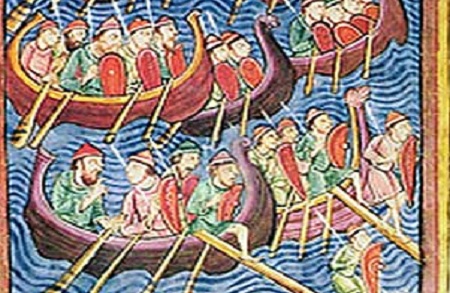
Officially, the Viking Age in the history books (which of course are written by the victors of wars), begins in the year 793ce with the destruction of the Priory or Abby called Linesfarne an island off the coast of eastern England.
Let’s look back with new information today and see if the story is as simple as told by the Catholic Clerics. According to Fordham University, that a noble from Saxony just across the North Sea in what is today the Netherlands and Germany, one Widikund was fighting against a war lord of the Catholic Church from France, Charlemagne. This battle or more to the point was a long series of attacks from the Franks over a thirty year long period. It seems that the Saxons were holding a yearly assembly where each district would send in 12 men from the three classes of men, the nobles, the freemen and the tenants. There were 100 districts in Saxony that Widikund was in leadership over and at this assembly of 100 districts there was a total of 3200 representatives. This is what Charlemagne attacked. In a day at a place called Verdun he beheaded 3600 men. That was the first attack. Many of the people fled, some to Denmark, as Denmark was still pagan and their king Godfred gave these victims protection, 782ce.
There was another defeat for the Saxons and the failure of the Saxons to keep the peace of a conquered people and fight, so angered Charlemagne that he had a formal document drawn up, most likely by the Catholic Church called the Saxon Capitulary, 785. Those that could not flee were put under this document, and many were taken south or put into abbeys if they were women, some just disappeared, thousand, tens of thousands over the 30 year campaign were ‘relocated’. So, if one of the Saxon children was hidden to avoid Baptism, Capital Offence, if one was found venerating a spring, Capital Offence, same also if found out in a holy grove, Capital Offence, speaking against Christianity, Capital Offence and from there, smaller offences and penalties.
The above mentioned Danish King Godfred had helped the refugees from Frisia and Saxony and he took to fighting back and while in Frisia he was murdered. His son or nephew, (seems some confusion here) became the new king and signed a peace with Charlemagne.
In a final battle possible where the Danish King was murdered, Widikund surrendered and was placed in an abbey, 810ce where he died. With this final defeat of the Saxons and Frisians Pope Hadrian wrote a glowing letter about Charlemagne and his crushing the pagans the Pope was so pleased with this that he made Charlemagne the first Holy Roman Emperor and was crowned as such.
With all of this cultural cleansing going others were attempting to fight back and as Professor Torgim Titlestad of Stavanger, Norway writes today, that he calls the attack on Lindnesfarne and Iona a pre-emptive attack against the forces of Christianity. My thoughts are the same and I would add that at the beginning of the Viking Age this in my opinion was the main point of the counter attack, however, people being people, there are always other motives such as just plain greed and lawlessness. Anyway, some Danish ‘Vikings’ attacked Paris and the Viking age began in earnest. Lindnesfarne was a place of intrigue, information about the pagans in Frisia, Denmark, and Saxony, the Bishops and priests were the “internet” of the day right back to Rome.
Just an end note when the monks wrote later that the northmen attacked they were most likely right because it seems that a chieftain from Hordaland, Norway a clan leader, Horda-Kari was a Dragon Slayer.
Thorgrun Odden
Gothi,
Asatru Folk Assembly
